Lexus GS300 2019 Owner's Manual
Manufacturer: LEXUS, Model Year: 2019, Model line: GS300, Model: Lexus GS300 2019Pages: 604, PDF Size: 14.6 MB
Page 491 of 604
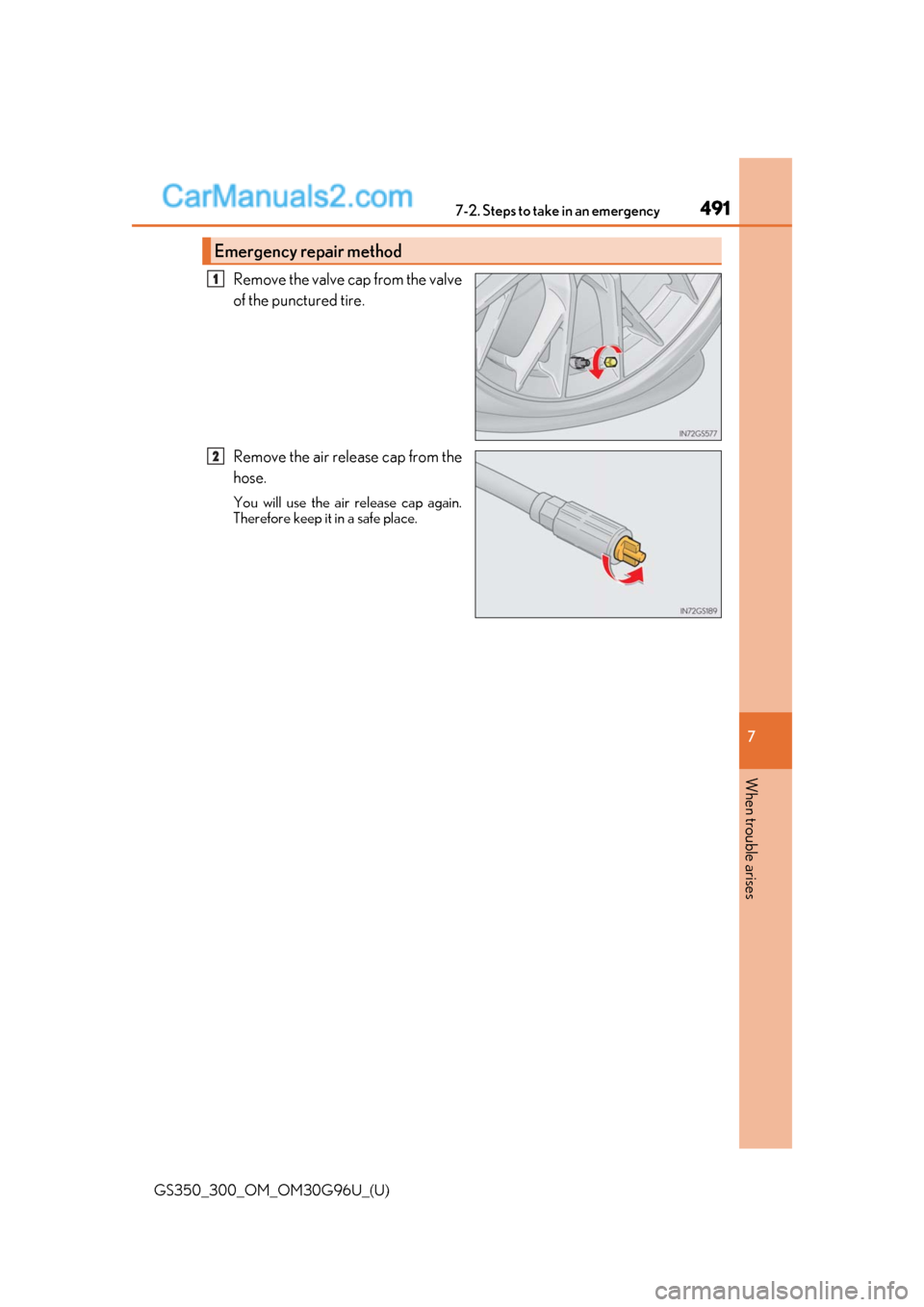
4917-2. Steps to take in an emergency
GS350_300_OM_OM30G96U_(U)
7
When trouble arises
Remove the valve cap from the valve
of the punctured tire.
Remove the air release cap from the
hose.
You will use the air release cap again.
Therefore keep it in a safe place.
Emergency repair method
1
2
Page 492 of 604
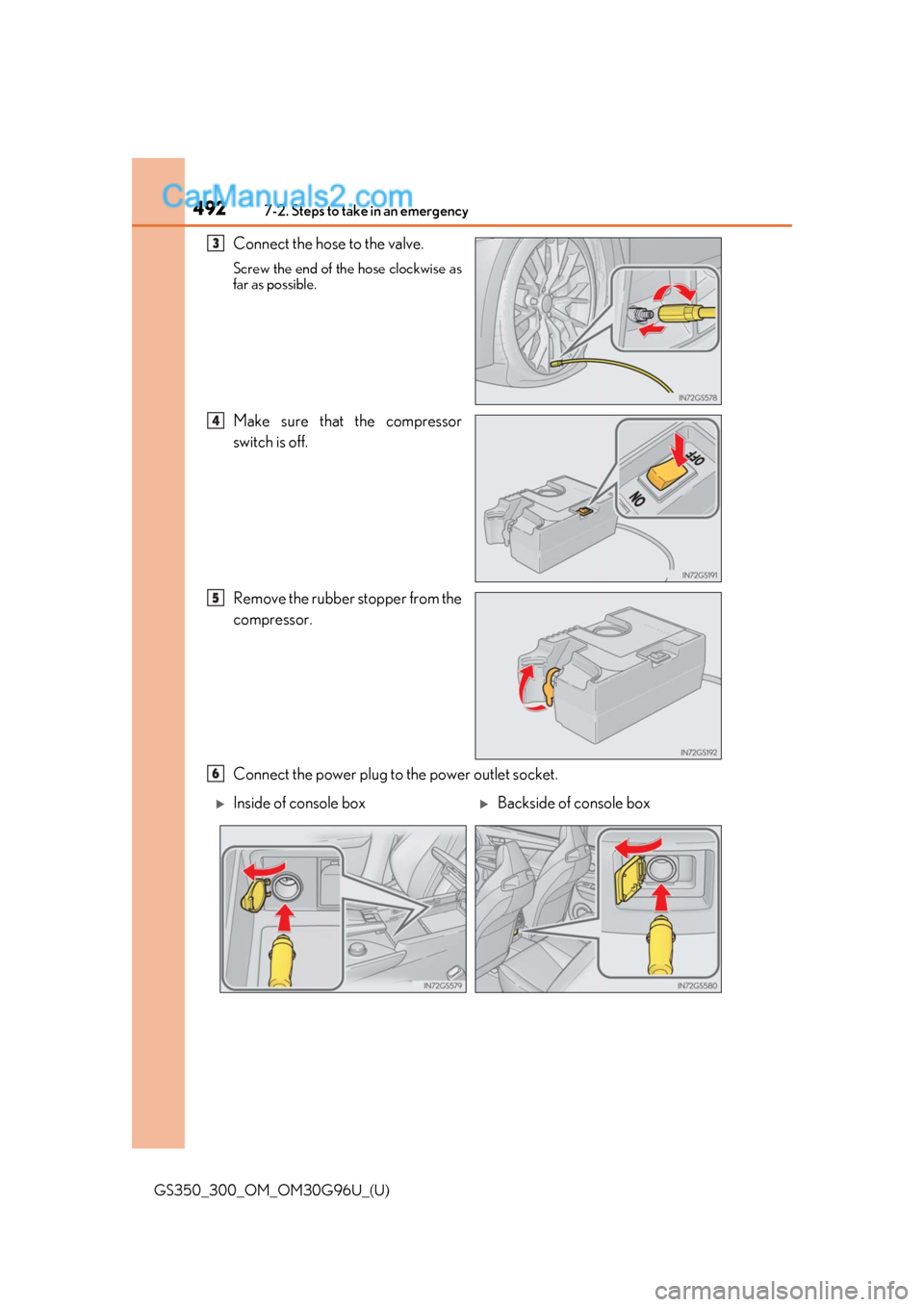
4927-2. Steps to take in an emergency
GS350_300_OM_OM30G96U_(U)
Connect the hose to the valve.
Screw the end of the hose clockwise as
far as possible.
Make sure that the compressor
switch is off.
Remove the rubber stopper from the
compressor.
Connect the power plug to the power outlet socket.
3
4
5
6
Inside of console boxBackside of console box
Page 493 of 604
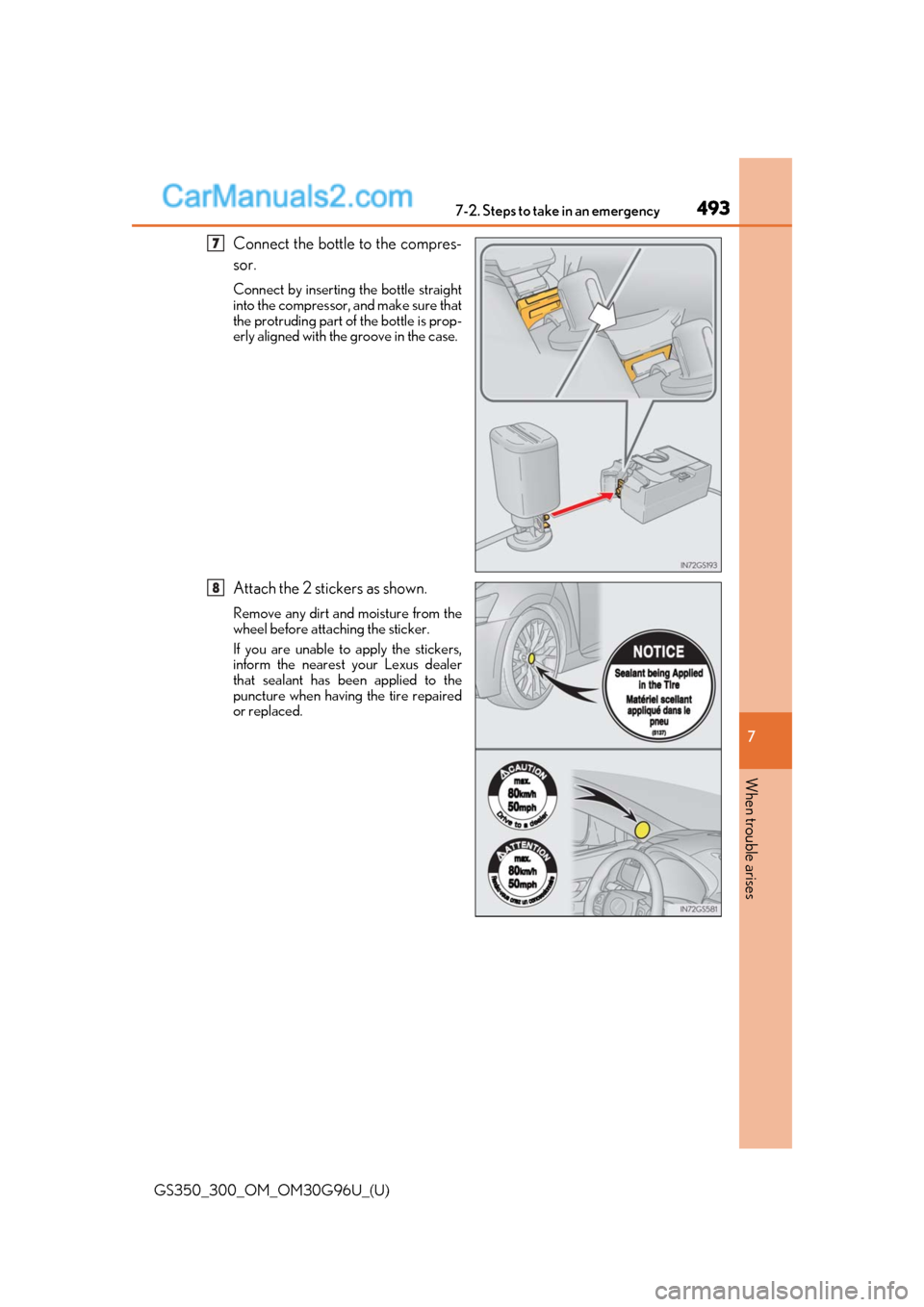
4937-2. Steps to take in an emergency
GS350_300_OM_OM30G96U_(U)
7
When trouble arises
Connect the bottle to the compres-
sor.
Connect by inserting the bottle straight
into the compressor, and make sure that
the protruding part of the bottle is prop-
erly aligned with the groove in the case.
Attach the 2 stickers as shown.
Remove any dirt and moisture from the
wheel before atta ching the sticker.
If you are unable to apply the stickers,
inform the nearest your Lexus dealer
that sealant has been applied to the
puncture when having the tire repaired
or replaced.
7
8
Page 494 of 604
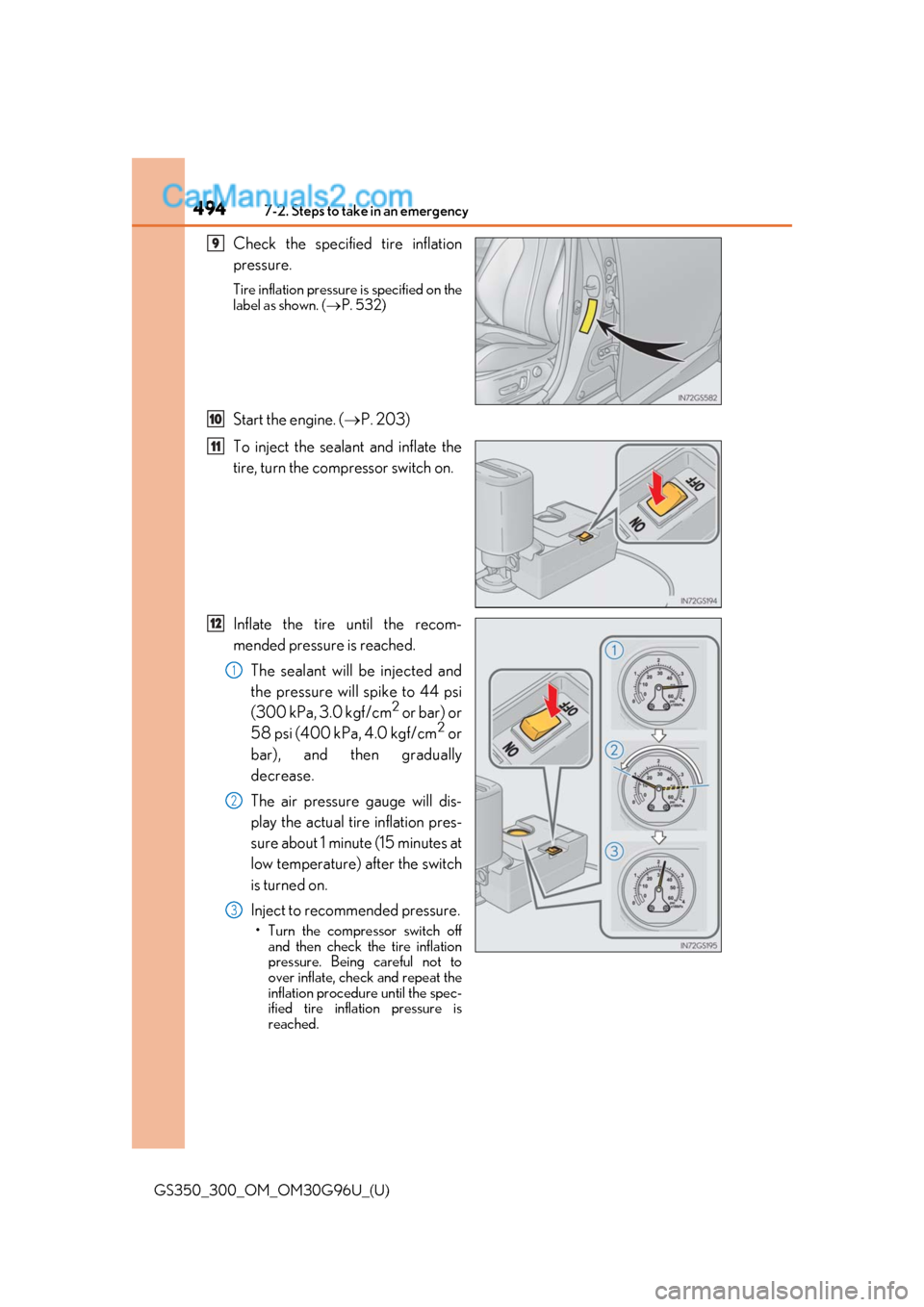
4947-2. Steps to take in an emergency
GS350_300_OM_OM30G96U_(U)
Check the specified tire inflation
pressure.
Tire inflation pressure is specified on the
label as shown. (P. 532)
Start the engine. ( P. 203)
To inject the sealant and inflate the
tire, turn the compressor switch on.
Inflate the tire until the recom-
mended pressure is reached. The sealant will be injected and
the pressure will spike to 44 psi
(300 kPa, 3.0 kgf/cm
2 or bar) or
58 psi (400 kPa, 4.0 kgf/cm2 or
bar), and then gradually
decrease.
The air pressure gauge will dis-
play the actual tire inflation pres-
sure about 1 minute (15 minutes at
low temperature) after the switch
is turned on.
Inject to recommended pressure.
• Turn the compressor switch off and then check the tire inflation
pressure. Being careful not to
over inflate, check and repeat the
inflation procedur e until the spec-
ified tire inflation pressure is
reached.
9
10
11
12
1
2
3
Page 495 of 604
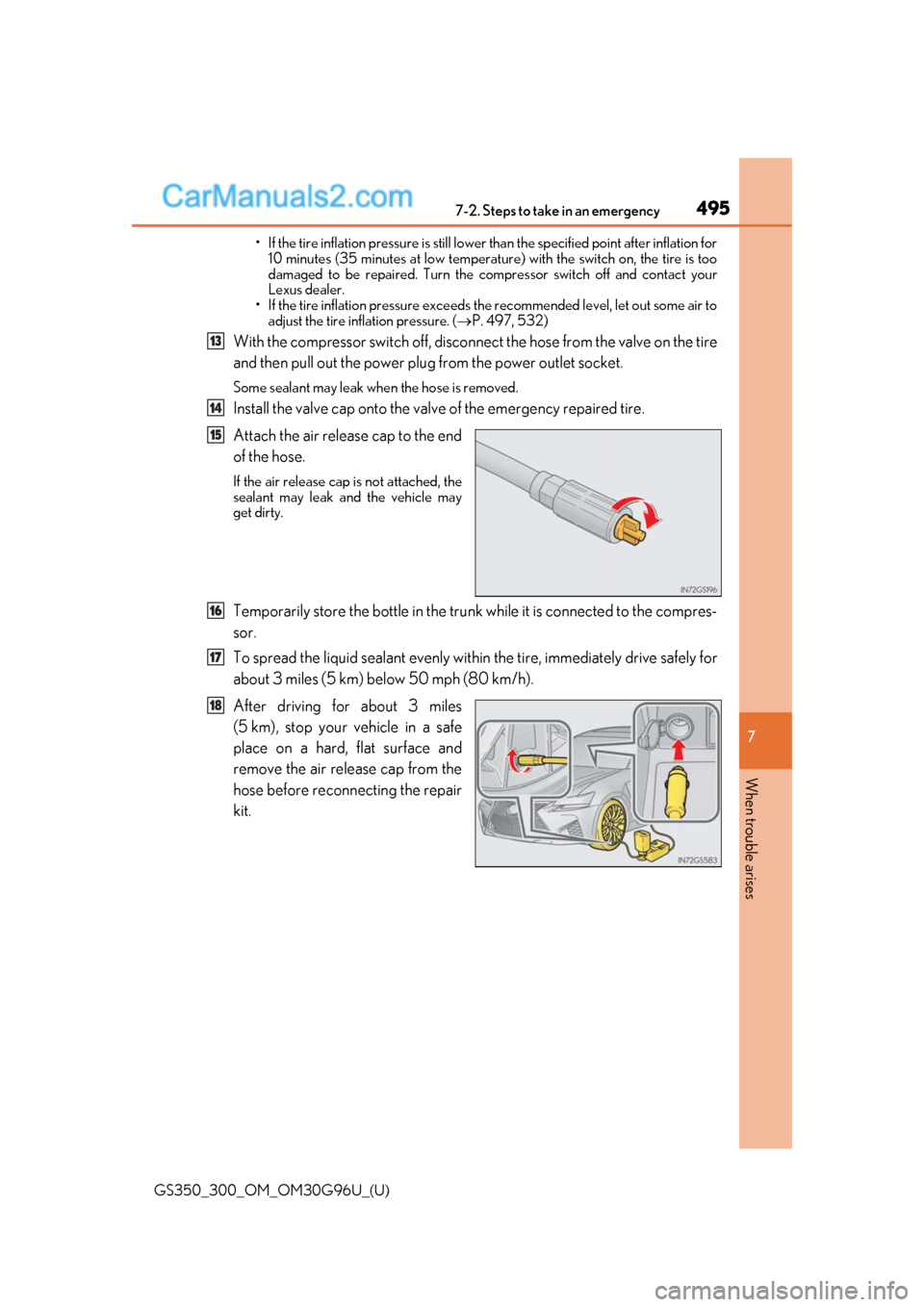
4957-2. Steps to take in an emergency
GS350_300_OM_OM30G96U_(U)
7
When trouble arises
• If the tire inflation pressure is still lower than the specified po int after inflation for
10 minutes (35 minutes at low temperature) with the switch on, the tire is too
damaged to be repaired. Turn the co mpressor switch off and contact your
Lexus dealer.
• If the tire inflation pressure exceeds th e recommended level, let out some air to
adjust the tire inflation pressure. ( P. 497, 532)
With the compressor switch off, disconnect the hose from the valve on the tire
and then pull out the power plug from the power outlet socket.
Some sealant may leak when the hose is removed.
Install the valve cap onto the valve of the emergency repaired tire.
Attach the air release cap to the end
of the hose.
If the air release cap is not attached, the
sealant may leak and the vehicle may
get dirty.
Temporarily store the bottle in the trunk while it is connected to the compres-
sor.
To spread the liquid sealant evenly within the tire, immediately drive safely for
about 3 miles (5 km) below 50 mph (80 km/h).
After driving for about 3 miles
(5 km), stop your vehicle in a safe
place on a hard, flat surface and
remove the air release cap from the
hose before reconnecting the repair
kit.
13
14
15
16
17
18
Page 496 of 604
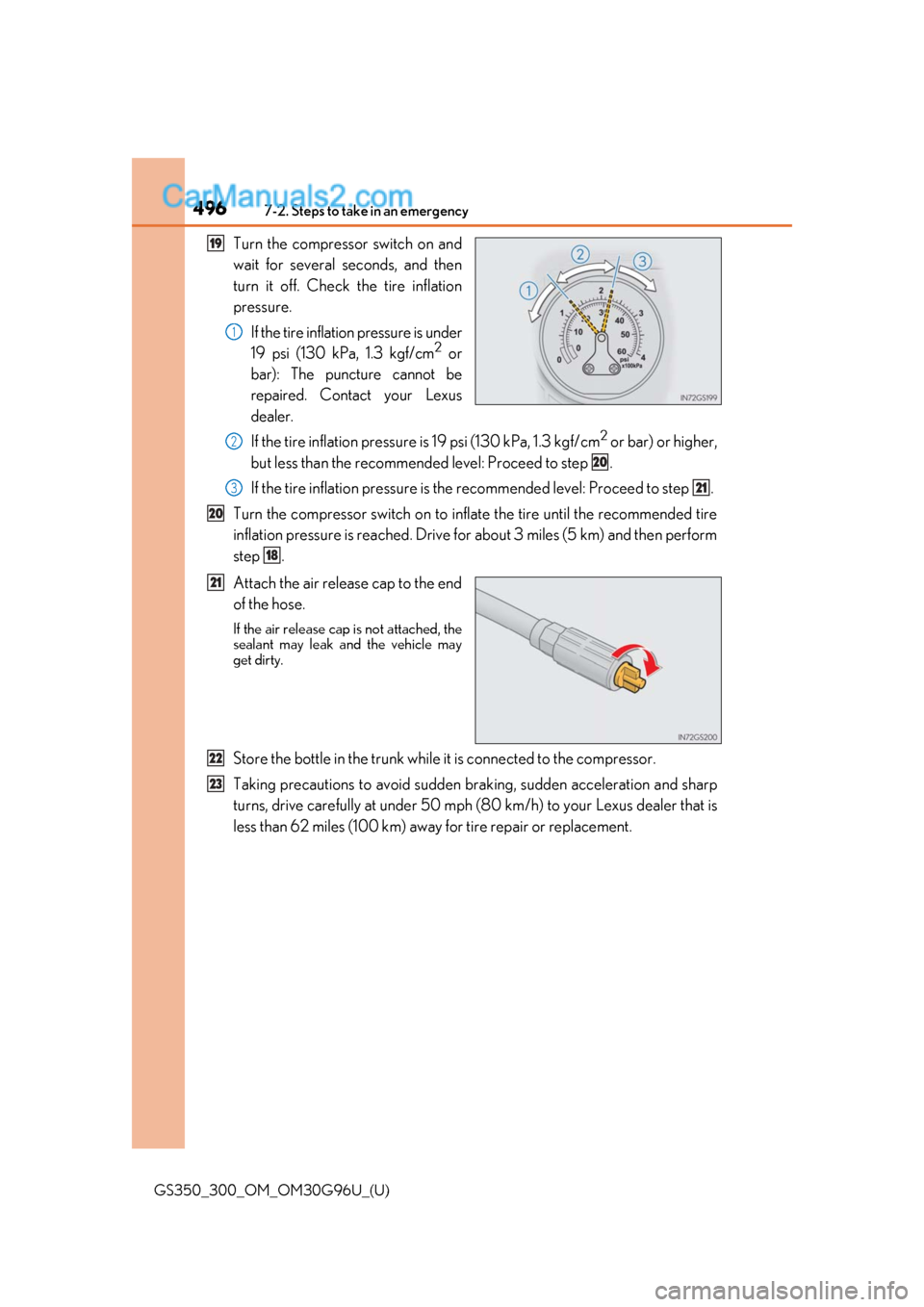
4967-2. Steps to take in an emergency
GS350_300_OM_OM30G96U_(U)
Turn the compressor switch on and
wait for several seconds, and then
turn it off. Check the tire inflation
pressure.If the tire inflation pressure is under
19 psi (130 kPa, 1.3 kgf/cm
2 or
bar): The puncture cannot be
repaired. Contact your Lexus
dealer.
If the tire inflation pressure is 19 psi (130 kPa, 1.3 kgf/cm
2 or bar) or higher,
but less than the recommended level: Proceed to step .
If the tire inflation pressure is the recommended level: Proceed to step .
Turn the compressor switch on to inflate the tire until the recommended tire
inflation pressure is reached. Drive for about 3 miles (5 km) and then perform
step .
Attach the air release cap to the end
of the hose.
If the air release cap is not attached, the
sealant may leak and the vehicle may
get dirty.
Store the bottle in the trunk while it is connected to the compressor.
Taking precautions to avoid sudden br aking, sudden acceleration and sharp
turns, drive carefully at under 50 mph (80 km/h) to your Lexus dealer that is
less than 62 miles (100 km) away for tire repair or replacement.
19
1
2
20
321
20
18
21
22
23
Page 497 of 604
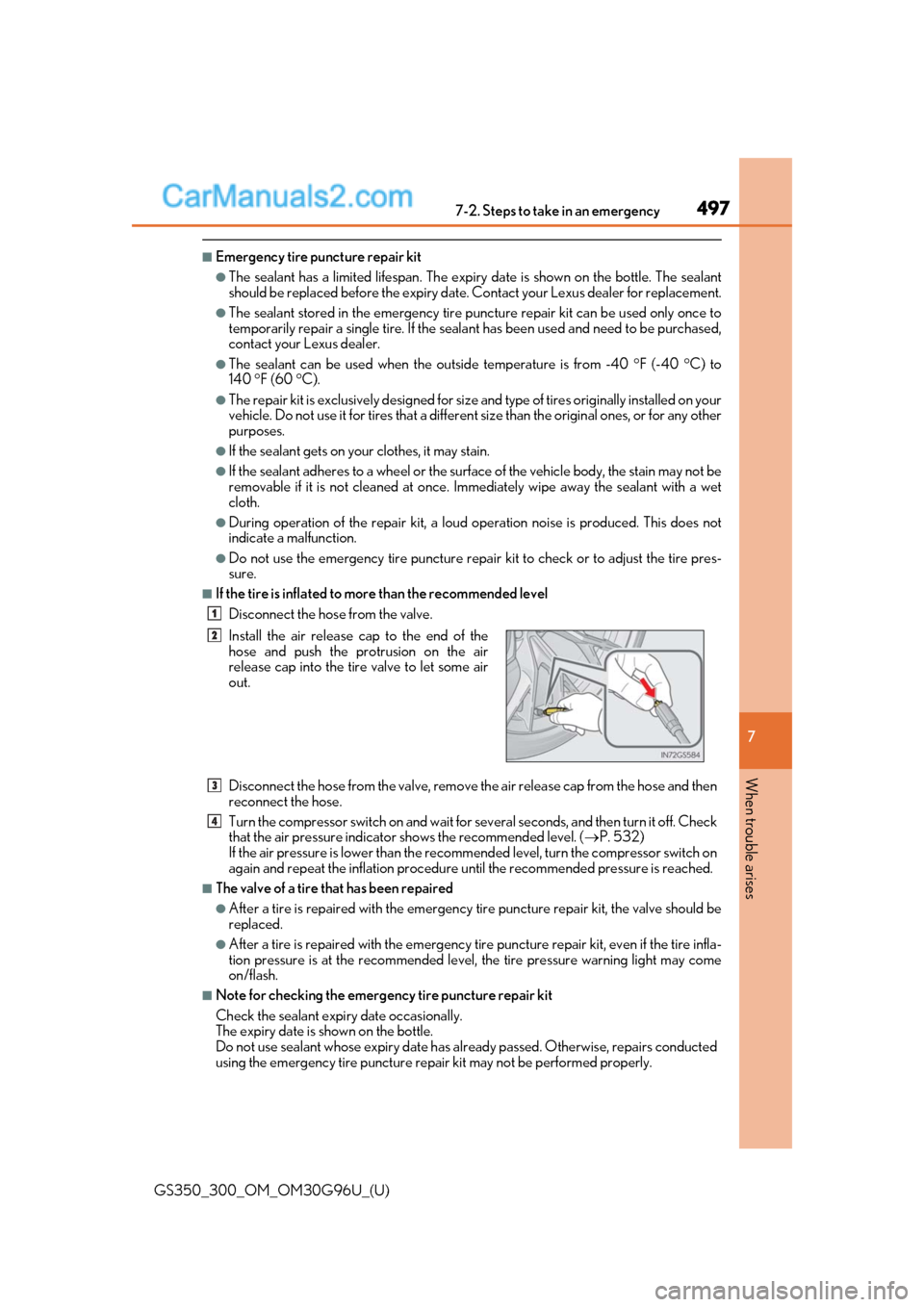
4977-2. Steps to take in an emergency
GS350_300_OM_OM30G96U_(U)
7
When trouble arises
■Emergency tire puncture repair kit
●The sealant has a limited lifespan. The expiry date is shown on the bottle. The sealant
should be replaced before the expiry date. Contact your Lexus dealer for replacement.
●The sealant stored in the emergency tire puncture repair kit can be used only once to
temporarily repair a single tire. If the sealant has been used and need to be purchased,
contact your Lexus dealer.
●The sealant can be used when the outside temperature is from -40 F (-40 C) to
140 F (60 C).
●The repair kit is exclusively designed for size and type of tires originally installed on your
vehicle. Do not use it for tires that a differen t size than the original ones, or for any other
purposes.
●If the sealant gets on yo ur clothes, it may stain.
●If the sealant adheres to a wheel or the surface of the vehicle body, the stain may not be
removable if it is not cleaned at once. Immediately wipe away the sealant with a wet
cloth.
●During operation of the repair kit, a loud operation noise is produced. This does not
indicate a malfunction.
●Do not use the emergency tire puncture repair kit to check or to adjust the tire pres-
sure.
■If the tire is inflated to mo re than the recommended level
Disconnect the hose from the valve.
Disconnect the hose from the valve, remove the air releas e cap from the hose and then
reconnect the hose.
Turn the compressor switch on and wait for several seconds, and then turn it off. Check
that the air pressure indicator shows the recommended level. ( P. 532)
If the air pressure is lower than the reco mmended level, turn the compressor switch on
again and repeat the inflation procedure un til the recommended pressure is reached.
■The valve of a tire that has been repaired
●After a tire is repaired with the emergency tire puncture repair kit, the valve should be
replaced.
●After a tire is repaired with the emergency tire puncture repair kit, even if the tire infla-
tion pressure is at the recommended level, the tire pressure warning light may come
on/flash.
■Note for checking the emergency tire puncture repair kit
Check the sealant expi ry date occasionally.
The expiry date is shown on the bottle.
Do not use sealant whose expiry date has al ready passed. Otherwise, repairs conducted
using the emergency tire puncture repa ir kit may not be performed properly.
Install the air release cap to the end of the
hose and push the protrusion on the air
release cap into the tire valve to let some air
out.
1
2
3
4
Page 498 of 604
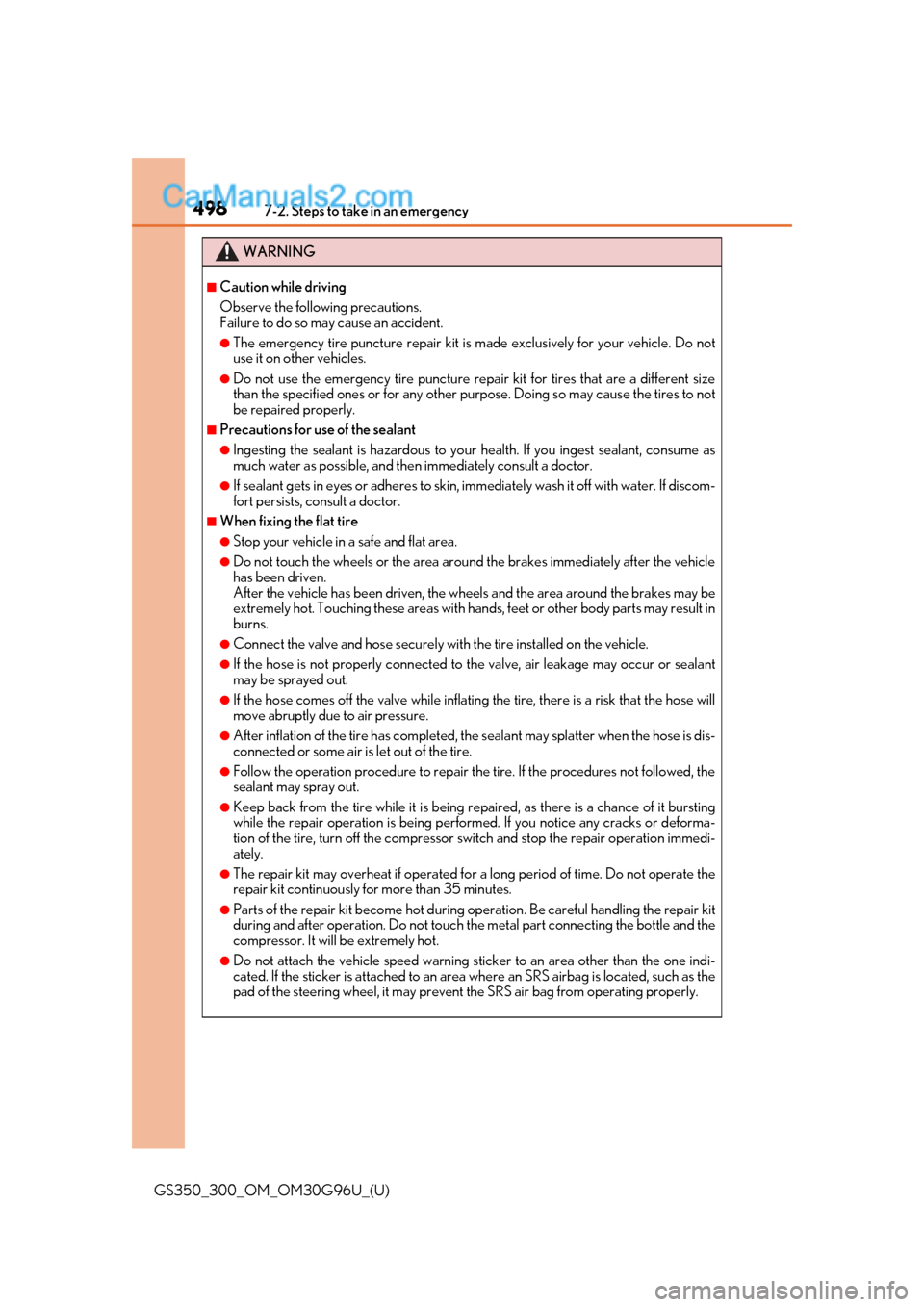
4987-2. Steps to take in an emergency
GS350_300_OM_OM30G96U_(U)
WARNING
■Caution while driving
Observe the following precautions.
Failure to do so may cause an accident.
●The emergency tire puncture repair kit is made exclusively for your vehicle. Do not
use it on other vehicles.
●Do not use the emergency tire puncture repa ir kit for tires that are a different size
than the specified ones or for any other pu rpose. Doing so may cause the tires to not
be repaired properly.
■Precautions for use of the sealant
●Ingesting the sealant is hazardous to your health. If you ingest sealant, consume as
much water as possible, and then immediately consult a doctor.
●If sealant gets in eyes or adheres to skin, immediately wash it off with water. If discom-
fort persists, consult a doctor.
■When fixing the flat tire
●Stop your vehicle in a safe and flat area.
●Do not touch the wheels or the area around the brakes immediately after the vehicle
has been driven.
After the vehicle has been driven, the wheels and the area around the brakes may be
extremely hot. Touching these areas with hands, feet or other body parts may result in
burns.
●Connect the valve and hose securely with the tire installed on the vehicle.
●If the hose is not properly connected to the valve, air leakage may occur or sealant
may be sprayed out.
●If the hose comes off the valve while inflating the tire, there is a risk that the hose will
move abruptly due to air pressure.
●After inflation of the tire has completed, the sealant may splatter when the hose is dis-
connected or some air is let out of the tire.
●Follow the operation procedure to repair the tire. If the procedures not followed, the
sealant may spray out.
●Keep back from the tire while it is being re paired, as there is a chance of it bursting
while the repair operation is being performed. If you notice any cracks or deforma-
tion of the tire, turn off the compressor sw itch and stop the repair operation immedi-
ately.
●The repair kit may over heat if operated for a long peri od of time. Do not operate the
repair kit continuously for more than 35 minutes.
●Parts of the repair kit become hot during oper ation. Be careful handling the repair kit
during and after operation. Do not touch th e metal part connecting the bottle and the
compressor. It will be extremely hot.
●Do not attach the vehicle speed warning sticker to an area other than the one indi-
cated. If the sticker is attached to an area where an SRS airbag is located, such as the
pad of the steering wheel, it may prevent the SRS air bag from operating properly.
Page 499 of 604
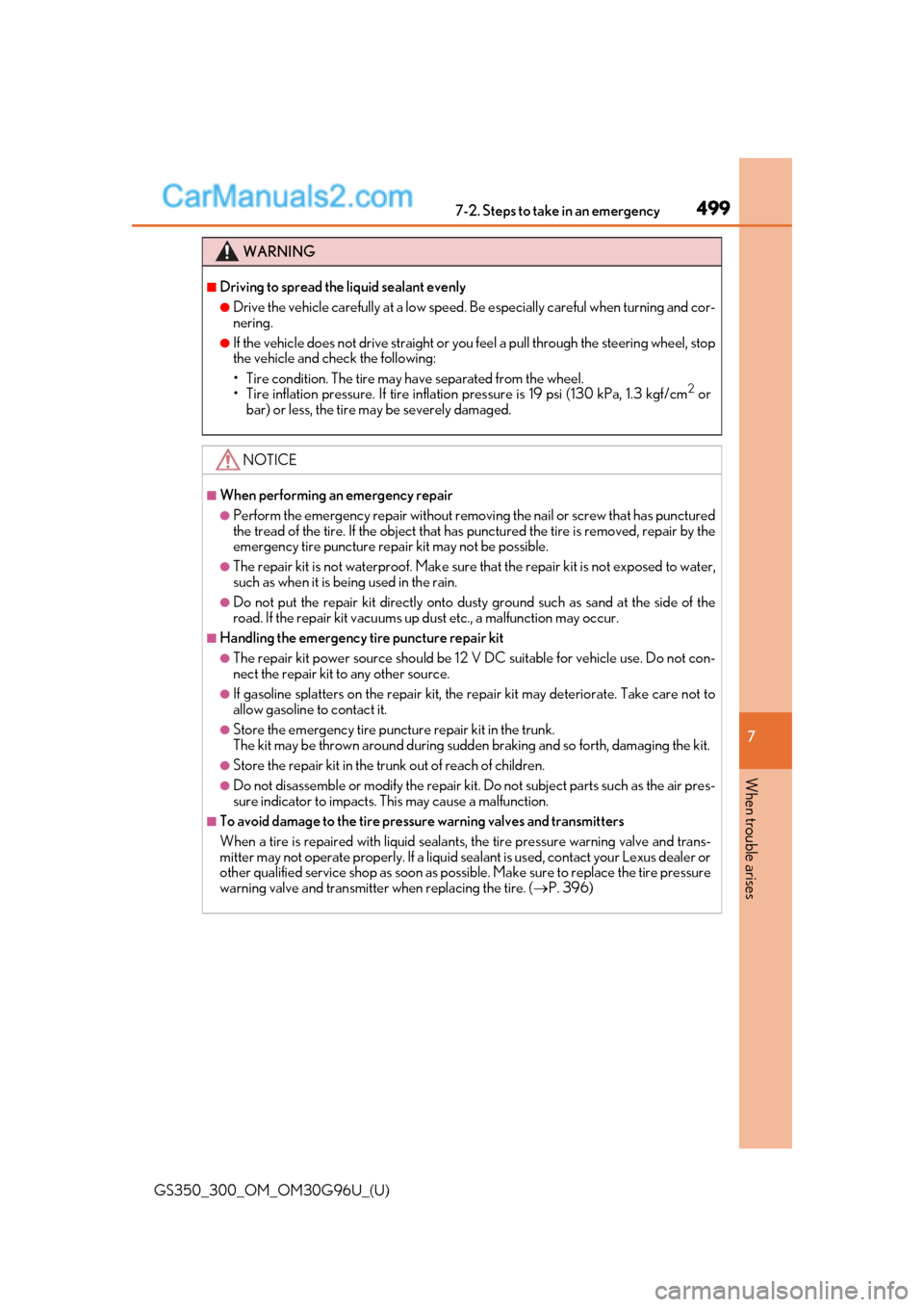
4997-2. Steps to take in an emergency
GS350_300_OM_OM30G96U_(U)
7
When trouble arises
WARNING
■Driving to spread th e liquid sealant evenly
●Drive the vehicle carefully at a low speed. Be especially careful when turning and cor-
nering.
●If the vehicle does not drive straight or you feel a pull through the steering wheel, stop
the vehicle and check the following:
• Tire condition. The tire may have separated from the wheel.
• Tire inflation pressure. If tire inflation pressure is 19 psi (130 kPa, 1.3 kgf/cm
2 or
bar) or less, the tire may be severely damaged.
NOTICE
■When performing an emergency repair
●Perform the emergency repair without removi ng the nail or screw that has punctured
the tread of the tire. If the object that has punctured the tire is removed, repair by the
emergency tire puncture repair kit may not be possible.
●The repair kit is not waterproof. Make sure that the repair kit is not exposed to water,
such as when it is be ing used in the rain.
●Do not put the repair kit directly onto dusty ground such as sand at the side of the
road. If the repair kit vacuums up dust etc., a malfunction may occur.
■Handling the emergency tire puncture repair kit
●The repair kit power source should be 12 V DC suitable for vehicle use. Do not con-
nect the repair kit to any other source.
●If gasoline splatters on the repair kit, the repair kit may deteriorate. Take care not to
allow gasoline to contact it.
●Store the emergency tire puncture repair kit in the trunk.
The kit may be thrown around during sudden braking and so forth, damaging the kit.
●Store the repair kit in the tr unk out of reach of children.
●Do not disassemble or modify the repair kit. Do not subject parts such as the air pres-
sure indicator to impacts. This may cause a malfunction.
■To avoid damage to the tire pressu re warning valves and transmitters
When a tire is repaired with liquid sealants, the tire pressure warning valve and trans-
mitter may not operate properly. If a liquid sealant is used, contact your Lexus dealer or
other qualified service shop as soon as possible. Make sure to replace the tire pressure
warning valve and transmitter when replacing the tire. ( P. 396)
Page 500 of 604
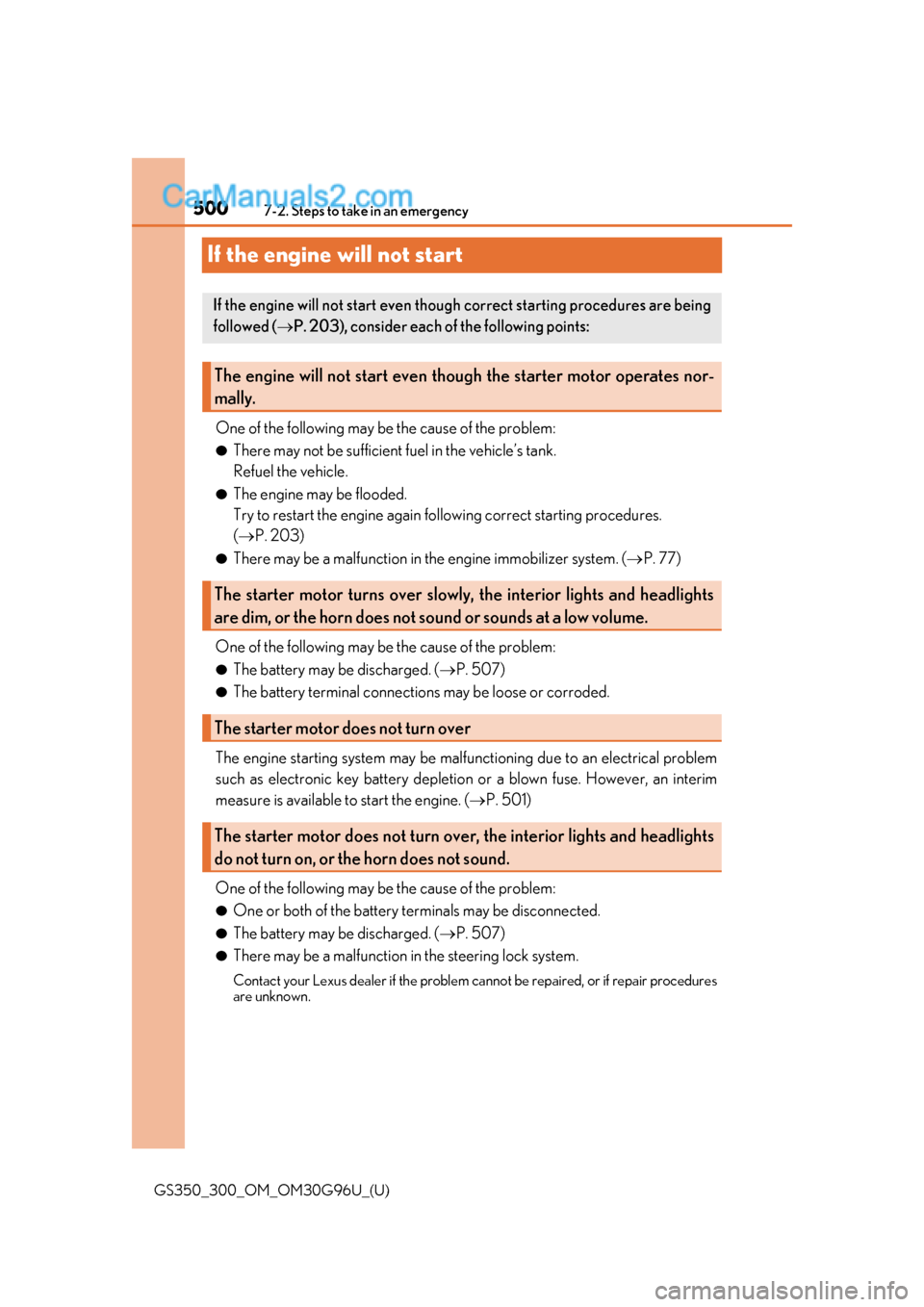
500
GS350_300_OM_OM30G96U_(U)7-2. Steps to take in an emergency
If the engine will not start
One of the following may be the cause of the problem:
●There may not be sufficient fuel in the vehicle’s tank.
Refuel the vehicle.
●The engine may be flooded.
Try to restart the engine again follo
wing correct starting procedures.
( P. 203)
●There may be a malfunction in th e engine immobilizer system. (P. 77)
One of the following may be the cause of the problem:
●The battery may be discharged. ( P. 507)
●The battery terminal connections may be loose or corroded.
The engine starting system may be malfun ctioning due to an electrical problem
such as electronic key battery depletio n or a blown fuse. However, an interim
measure is available to start the engine. ( P. 501)
One of the following may be the cause of the problem:
●One or both of the battery terminals may be disconnected.
●The battery may be discharged. ( P. 507)
●There may be a malfunction in the steering lock system.
Contact your Lexus dealer if the problem cannot be repaired, or if repair procedures
are unknown.
If the engine will not start even though correct starting procedures are being
followed (P. 203), consider each of the following points:
The engine will not start even thoug h the starter motor operates nor-
mally.
The starter motor turns over slowly , the interior lights and headlights
are dim, or the horn does not sound or sounds at a low volume.
The starter motor does not turn over
The starter motor does not turn over, the interior lights and headlights
do not turn on, or the horn does not sound.